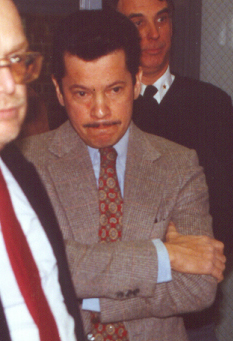

�� ���Dr. Peter Haughton was the� New Paltz campus physician at the time of the PCB disaster. This� was his reaction during the first news conference held the day� after the explosions and fires, Dec. 30, 1992. He later joined� the chorus of voices reassuring students, parents and faculty� of the safety of the campus and buildings. Nine years later,� this photo says it all.

�� ���We left the news conference� when it ended and went exploring. This mystery turned out to� be the "staging area" outside Gage Hall, from where� emergency crews ran their search & rescue and other emergency� operations, and where students and other exposure victimes had� their clothing and jewelry taken from them the day before. They� were then shuttled to area hospitals in ambulances wrapped in� blankets; there were not enough ambulances in the region to take� everyone at once. Doctors told them to go home and shower with� soap; there was nothing that could be done for them. The photo� below is about 200 feet from the stagine area, though about three� weeks later.

�� ���Some weeks� later, we watched as workers began the process of undong the� damage. Here, haz-mat men in level B work outside
�Gage Residence� Hall,� which college officials informed parents would be closed in the� spring semester of 1992. That seemed obvious enough. But at the� last minute, the 370 students were given the go-ahead to move� back into the building. Thus began what in the lingo of the cleanup� became known as the "Gage-type scenario," in which� students were allowed to live in a building either while cleanup� workers did their jobs, or with decontamination taking place� during vacations. A barrier fence was put up between the street� and the clean-up project, but students could watch from their� rooms. Gary Pinsky-Adamson said he would give coffee to haz-mat� workers out his window in Gage Hall, which was opened just 33� days after an explosion sent smoke flooding through the building.� In the words of firefighter Patrick Koch, one of four volunteer� firefighters to enter the building, "All you saw was smoke." Over the� next three years, I would work through Woodstock Times
, with the help of� a gadfly state official inside the Department of Environmental� Conservation named Ward Stone, and with the direct help of the� Governor's office, to establish that the vents in Gage Hall had� never been cleaned, had never been tested, and were in fact contaminated.� In the summer of 1994, the state performed an "arm's length� cleanup" of the vents and moved students back into the building,� once again reassuring them of its safety. Thus, the Gage cleanup� went on for three years with students living in the structure.� Today 370 students live there. No tests have ever been run on� heaters or heating conduits, and the vents remain contaminated� just 24 inches inside the grates.